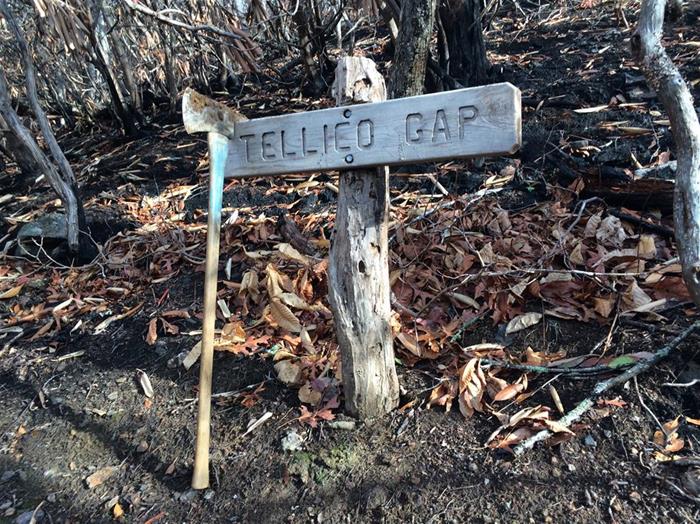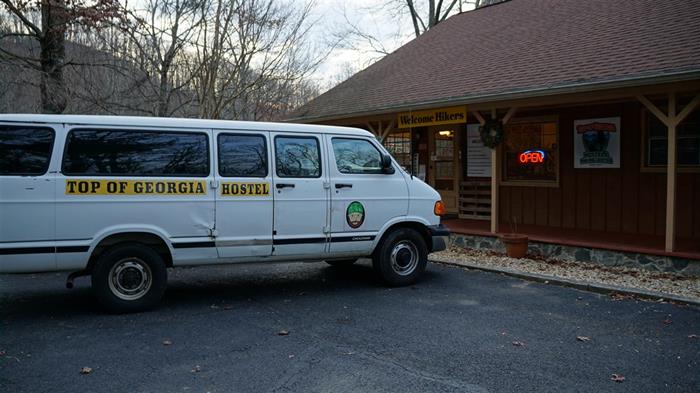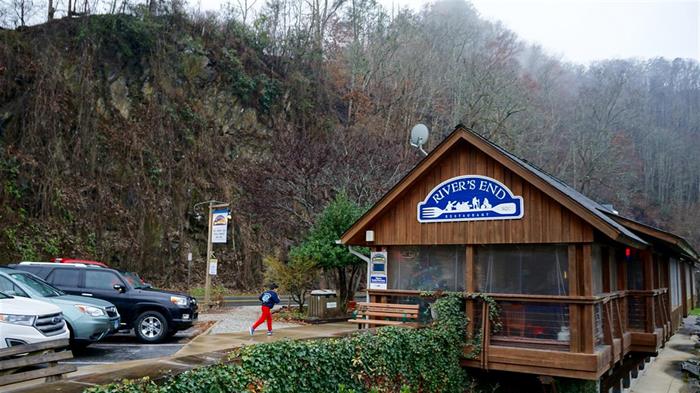by Jim Fetig
More Than Fire: The effects of the Southeast wildfires on the Appalachian Trail community
March 3, 2017
When people think of forest fires, they tend to imagine blackened death-like scenes with scorched earth and wildlife frantically fleeing from roaring flames. They envision a chaos of downed trees and a thick carpet of ashes, all of it there to ruin their outdoor experiences and even the trails themselves.
The effects of forest fires are generally less than imagined. Regardless, fire means more than charred land and trees. Fire also touches hikers themselves and the hiking-related businesses that support them.
150 miles of the Appalachian Trail (A.T.) were closed at various times this fall — 72 in Great Smoky Mountains National Park, 68 in North Carolina, and ten in Georgia. Hikers expressed concerns on social media about Trail conditions and whether the needed support would be there for them when northbound thru-hiking season starts this spring. Since then, the maintaining clubs, the U.S. Forest Service and the National Park Service have inspected the burned areas in detail.
Their findings offer good news: in spite of some unsightly scorching, the fire damage should have minimal impact on the 2017 thru-hiking season. All of the burned areas are open to hikers.
To get a full picture of how the fires affected the hiking community, I made a whirlwind trip in December throughout the Southeast, stopping in Hot Springs, Franklin, and the Nantahala Outdoor Center in North Carolina; Gatlinburg, Tennessee; and Hiawassee, Georgia. Along the way, I talked with business owners and thru-hikers to get their perspectives of the human impacts of the 2016 fires. In January, I also participated in a maintaining crew in the Tellico Gap, North Carolina burn area so I could see the damage first hand in an area where the fire burned across the Trail.

The A.T. section through the Nantahala National Forest was directly impacted by wildfire crossing directly over the footpath itself.
The fires in the southern region burned mostly in the fall, but the first fire blazed in April within Shenandoah National Park forcing hikers to shuttle around it. Through out the 2016 season, fires forced hikers and their supporters to innovate to keep the forward progress underway. The Appalachian Trail Conservancy (ATC) announced that thru hikers could bypass those short stretches near Hot Springs and Shenandoah without penalty and still be considered thru-hikers.
In truth, the story starts long before the fires did. Above average temperatures and prolonged drought were factors that helped cause the fires and affected business throughout the Southeast, though each region had a unique experience.
Georgia
North Georgia was hit first, suffering from drought in the early spring with extreme dry conditions extending into late fall. North Carolina, though parched, reported water sources flowing past their normal dates in some cases, according to Dan Gallagher, owner of Bluff Mountain Outfitters in Hot Springs. In every case, diminished rainfall helped make the woodlands tinder dry and fire ready.
As the hiking season continued to unfold, the temperatures in North Georgia were warmer than normal. The region received approximately 52 percent less rain than the previous year, causing mountain springs to dry up early. The effects of the drought further north were mitigated a bit by slightly more rainfall. This drought ultimately affected hikers and businesses alike in locations as far away as Atlanta. Image courtesy of the U.S. Forest Service.

The wildfires in North Georgia, including those near the A.T. and the Rough Ridge Fire further west (pictured here), filled the air with smoke and ash. Visibility and air quality was affected
Ron Brown of Ron’s Shuttle Service, which operates between Atlanta and Fontana Dam, said he and other shuttle operators did what they could to help hikers find water.
“Hikers are a resourceful bunch,” he said. “Anything to keep them going.”
Brown noted that his business overall was down with a significant drop-off in section hikers and backpackers as the summer drought set in. He said that he shuttled more day hikers than ever before, however, and was able to make up for some of the summer section hiker business he lost.
The drought and warm temperatures put an early hit on the non-profit Top of Georgia Hostel managed by Bob “Sir Packs-A-Lot” Gabrielsen. He noted that many hikers buy warmer equipment from his gear shop in colder years — this year, due to the heat, gear sales were a fraction of what they had been the previous year.
“When it’s 75 and sunny, nobody buys rain gear or a warmer sleeping bag,” he said.

Top of Georgia Hostel – While businesses like the Top of Georgia Hostel may not have been physically damaged by the fires, the situation has weakened visitation and heavily impacted hiking gear sales.
In addition to a drop in gear sales, overnight stays at the hostel decreased since fewer section hikers took to the drought-ridden Trail during the summer and fall — and for the most part, day hikers don’t stay in hostels.
Later in the fall, as forest fires encroached within two miles of the hostel, Gabrielsen said his proximity to the fires put his business on an officially imposed pre-evacuation footing. The rules prevented the hostel from taking in hikers for a critical part of the southbound season.
“The fires burned within two miles and the smoke was thick,” he said.
The hostel was so heavily impacted by drought and fires that Gabrielsen established a “Go Fund Me” campaign to help the non-profit hostel stay viable. However, he remains committed to supporting hopeful hikers on their journeys.
“We plan to be open through the winter and here for NOBOs in the spring,” he said.
North Carolina
According to Colin Gooder, owner of the Gooder Grove Hostel, the same fires also had a detrimental effect on business in Franklin.
“Most southbounders skipped Franklin and went straight to Hiawassee,” he said, causing them to miss nearly 70 miles of the A.T.
Gooder felt sorry for those who had to skip this much of the Trail after hiking all that way, but he and many others in Franklin offered as much support as possible to hikers stranded by the fires.
“Franklin has an incredible support system for hikers,” Gooder said. “Some stayed with us and slacked for three days to make up for lost time.”
Gooder noted that Franklin was covered in smoke off-and-on for about two weeks. He praised the U.S. Forest Service for opening the trail “as quickly as possible.”
Further north, fires burned up from the edge of U.S. Highway 19, directly across from the hiker-favorite Rivers End Restaurant at the Nantahala Outdoor Center (NOC). The restaurant and adjacent outfitter were closed for five days, but thanks to firefighters’ efforts, neither suffered any damage and reopened soon afterward.

U.S. Highway 19 separated the Nantahala Outdoor Center (NOC) from the fires. Thankfully, none of the NOC buildings suffered any fire damage.
I stopped for lunch and to chat with the wait staff at River’s End Restaurant. The food, of course, is as tasty as it ever was.
Early spring fires closed sections of the A.T. near Hot Springs. With the trail closed and crowds of hikers coming in, Gallagher said that for 14 days in April, he and local volunteers shuttled hikers around the Hot Springs fire free of charge.
Tennessee
The fire that burned a portion of Gatlinburg, Tennessee was started by careless teens playing with matches while hiking on the Chimney Top Trail in the Great Smoky Mountains National Park. The resulting Chimney Top Fire burned right to the parking lot of a second NOC Outfitter store located in Gatlinburg. The store suffered no damage, though one employee said she lost 10 days work.
The Grand Prix motel — considered by many to be the most hiker-friendly motel in the area — survived the fires, though the flames came uncomfortably close. The motel is under new management and significant renovation, and no one could be reached to determine if the motel would be open by spring.
Here is the good news: the fire did not reach the A.T. in the Great Smoky Mountains National Park. Further south in North Carolina, the fire did scorch the Trail and burn vegetation, but the only structure along the A.T. damaged by the fires was the Wayah Bald Tower, which lost its roof (seen below).

Wayah Bald Tower, before and after wildfire passed over its namesake mountain.
Hikers also said that they met maintainers from the Nantahala Hiking Club who were actively working on the trail and shelters in the fire areas. In addition, the Appalachian Long Distance Hikers Association (ALDHA) has experienced volunteer maintainers ready to assist if need be. Ron Tipton, president and CEO of the ATC, said that additional crews would be organized if needed.
During the Northern Ruck, a seminar weekend for potential thru-hikers, I participated in a work trip with the Nantahala Hiking Club in the Tellico Gap, North Carolina burn area. There the fire burned off the duff on the forest floor and severely scorched tree and laurel roots, exposing the mostly-dirt treadway to potential erosion. The maintainers repaired minor damage to the treadway and dug into the side hill to enlarge and level the path to help prevent future erosion.

Volunteer crews repaired sections of the Trail directly impacted by the fire, helping to prevent increased erosion in the future.
Franklin Lafond, who volunteers with the Smoky Mountain Hiking Club and serves as trails supervisor for the club’s Nantahala National Forest A.T. section, organized the work trip and noted that the fire area maintaining clubs have had weekly work trip since the fires. They will continue to work through the winter to shore up the Trail and ensure it is ready this spring.
Business owners are optimistic and plan to be there to support hikers in the spring. Gooder is adding an additional bunkroom, bringing his indoor capacity to approximately 30 hikers with additional space for those who want to tent or hang their hammocks.
Members of the Nantahala Hiking Club and ATC Southern Regional Director Morgan Sommerville express their sincere thanks to all who donated to help deal with forest fire damage along the A.T. in North Carolina.
“The contributed funds will be used to run three weeks of ATC’s Konnarock Volunteer Trail Crew working on the most severely damaged A.T. section between Tellico Gap and Wesser, North Carolina, and to purchase any materials and logistics needed for the Trail rehabilitation work,” said Sommerville.
The bottom line: everyone is looking forward to meeting the Class of 2017 as they begin their personal adventures this spring and the A.T. will be ready. In the meantime, I encourage those traveling through these areas to stop by these A.T. communities affected by the drought fires and show them the same kind of support they give hikers.

The Appalachian Trail heading north at Newfound Gap, Great Smoky Mountains National Park.
As always, hikers should exercise caution and situational awareness in any burned areas. Maintainers are removing hazardous trees from around shelters and officially designated camping areas, but fire-damaged trees or limbs could fall anywhere at any time — be sure to look above and inspect any area where you intend to camp or linger, especially in higher winds.
The same situational awareness should be placed on the footpath itself, especially in areas where fires crossed over the Trail between Tellico Gap and the NOC. The fires may have burned some of the structures supporting the Trail, including tree roots and logs, which could affect the stability of the footpath. If you see a section that looks significantly damaged or unstable, take note of its location and report it to the ATC as soon as possible.
While winter rain has been normal so far, the drought also means most Southeast water sources could be dry. Before heading out, be sure to check http://appalachiantrail.org/updates and be cautious about building fires or using alcohol or tablet stoves.
